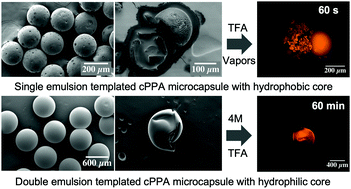Fabrication of pH-responsive monodisperse microcapsules using interfacial tension of immiscible phases†
Abstract
Monodisperse, stimuli-responsive microcapsules are required for applications involving precise delivery of chemical payloads but are difficult to fabricate with high throughput and control over capsule geometry and shell wall properties, especially in the presence of organic solvents. In this paper, we adapt a facile technique based on the interfacial tension of immiscible phases for the generation of monodisperse emulsion templates and microcapsules. In this technique, either one (single emulsion) or two (double emulsion) dispersed phases are simultaneously delivered while reciprocating across the interface of a stationary immiscible continuous phase. The interfacial tension of the continuous phase results in the separation of a monodisperse droplet in every cycle. Monodisperse single emulsion-templated microcapsules based on cyclic poly(phthalaldehyde) (cPPA) and polymethacrylate (Eudragit E100) shell walls are formed with hydrophobic cores. The acid-triggered release of Eudragit and cPPA microcapsules containing an oil core is demonstrated in an acidic media. Tunable, monodisperse double emulsion templates with an aqueous core are formed with sizes ranging from 295 μm to 1200 μm and reciprocation frequencies of 1 Hz to 7 Hz. The double emulsion templates are converted to monodisperse, responsive microcapsules with a hydrophilic core through photocuring or selective solvent evaporation to form the polymer shell wall. Microcapsules with a variety of polymeric shell walls based on photocurable polyisocyanurate, cPPA and polylactide are fabricated. The acid-triggered release of cPPA microcapsules containing an aqueous core with a slower degradation rate is also demonstrated. We achieve excellent control over the emulsion templates and microcapsules, with polydispersity less than 2% and the ability to predict the size reliably based on process parameters. The cost-effectiveness, ease of fabrication and potential for scale-up make this technique very promising for fabrication of a diverse range of stimuli-responsive microcapsules.



 Please wait while we load your content...
Please wait while we load your content...